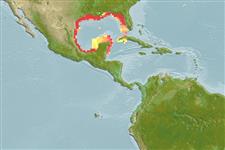Teleostei (teleosts) >
Tetraodontiformes (Puffers and filefishes) >
Tetraodontidae (Puffers) > Tetraodontinae
Etymology: Sphoeroides: Greek, sphaira = ball + Greek, suffix, oides = similar to (Ref. 45335).
Environment: milieu / climate zone / depth range / distribution range
Ecology
Marine; brackish; demersal. Subtropical; 31°N - 18°N, 98°W - 82°W
Western Atlantic: northern and western Gulf of Mexico, from northwestern Florida in USA to Campeche in Mexico.
Size / Weight / Age
Maturity: Lm ? range ? - ? cm
Max length : 15.0 cm TL male/unsexed; (Ref. 7251)
Dorsal spines (total): 0; Dorsal soft rays (total): 8; Anal spines: 0; Anal soft rays: 7. Dorsally and laterally, basal pigmentation is a light grey or brown, with numerous spots and blotches, especially evident on lower flanks, where they form an irregular row near the ventrolateral body angle. An axil spot present, but is no more intense than other lateral spots and blotches. Ventral surface unpigmented. Prickles present from the snout to near dorsal fin, and chin to near to near anus ventrally, and present laterally on cheeks and to near level of dorsal fin. Lappets absent (Ref 53033).
Inhabits shallow, turbid coastal waters and estuaries.
Life cycle and mating behavior
Maturity | Reproduction | Spawning | Eggs | Fecundity | Larvae
Robins, C.R. and G.C. Ray, 1986. A field guide to Atlantic coast fishes of North America. Houghton Mifflin Company, Boston, U.S.A. 354 p. (Ref. 7251)
IUCN Red List Status (Ref. 130435: Version 2024-1)
Threat to humans
Harmless
Human uses
Fisheries: commercial
Tools
Special reports
Download XML
Internet sources
Estimates based on models
Preferred temperature (Ref.
123201): 23.2 - 27.1, mean 24.2 °C (based on 188 cells).
Phylogenetic diversity index (Ref.
82804): PD
50 = 0.5000 [Uniqueness, from 0.5 = low to 2.0 = high].
Bayesian length-weight: a=0.02291 (0.01031 - 0.05092), b=2.89 (2.72 - 3.06), in cm total length, based on LWR estimates for this Genus-body shape (Ref.
93245).
Trophic level (Ref.
69278): 3.4 ±0.4 se; based on size and trophs of closest relatives
Resilience (Ref.
120179): High, minimum population doubling time less than 15 months (Preliminary K or Fecundity.).
Fishing Vulnerability (Ref.
59153): Low vulnerability (10 of 100).
